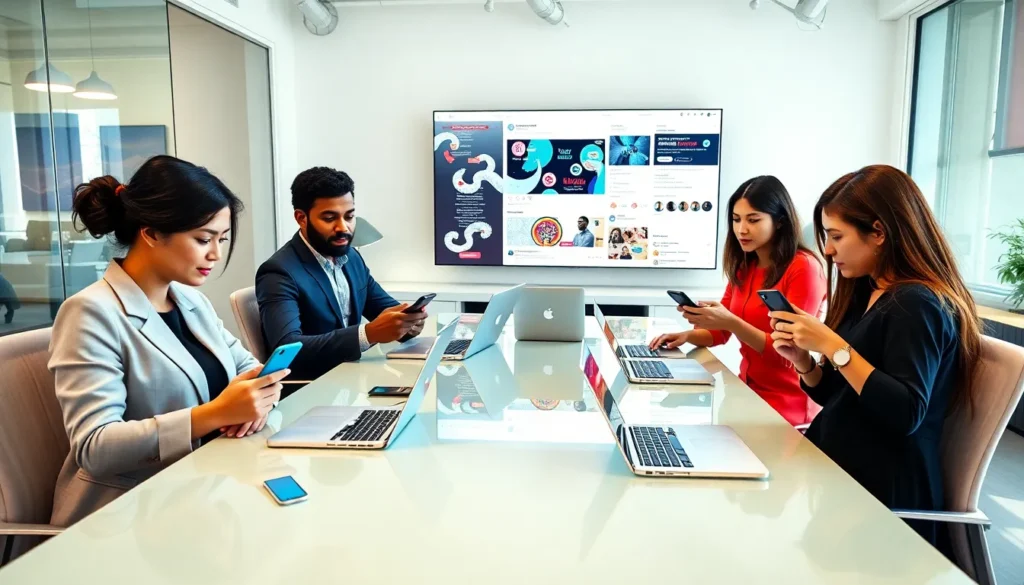In a world where smartphones are practically an extension of ourselves, keeping them secure is no laughing matter—unless you count the times you accidentally leave it on the roof of your car. Mobile devices hold a treasure trove of personal information, making them prime targets for cybercriminals. But fear not! With the right mobile device security solutions, you can turn your phone into a digital fortress.
Table of Contents
ToggleOverview of Mobile Device Security Solutions
Mobile device security solutions focus on protecting smartphones and tablets from potential threats. These solutions include a variety of tools designed to safeguard sensitive information.
Antivirus software plays a critical role in detecting and removing malicious software. Regular updates ensure that devices remain protected against the latest threats.
Mobile Device Management (MDM) systems help organizations secure and manage employee devices. Companies can enforce security policies, remotely wipe data, and track devices if lost or stolen.
Encryption provides another layer of security by converting data into an unreadable format. In case of unauthorized access, sensitive information remains protected.
Two-Factor Authentication (2FA) strengthens access security. Users can receive verification codes via SMS or email, adding an extra step to the login process.
Virtual Private Networks (VPNs) protect internet connections by encrypting data. When accessing public Wi-Fi, VPNs reduce the risk of interception by cybercriminals.
Regular backups serve as a safety net in case of data loss. By storing information securely, users can restore critical files quickly and efficiently.
Employee training is essential for maintaining mobile device security. Employees should recognize phishing attempts and understand best practices for using devices safely.
Firewalls act as barriers between trusted internal networks and untrusted external networks. Configuring firewalls effectively reduces the risk of unauthorized access to devices.
All these solutions combined create a robust framework for securing mobile devices and the sensitive data they hold. Adopting a multi-layered approach ensures comprehensive protection against evolving threats.
Types of Mobile Device Security Solutions
Mobile device security solutions provide essential protection for personal and organizational data. Various methods ensure devices remain secure against potential threats.
Antivirus and Anti-Malware Software
Antivirus software detects and removes malicious programs from devices. These programs scan files and applications, offering real-time protection against threats. Regular updates enhance effectiveness by addressing new viruses and malware. Users gain peace of mind knowing their devices are monitored for suspicious behavior. Many options include additional features, such as browser protection and spam filtering, to further safeguard user experience.
Mobile Device Management (MDM)
Mobile Device Management (MDM) systems enable organizations to oversee and control employee devices. Administrators can enforce security policies, such as requiring password protection or remotely wiping data. MDM solutions help track device locations, ensuring lost or stolen devices can be managed promptly. Integration with existing IT infrastructure creates seamless security operations, minimizing risks associated with mobile usage. Many organizations experience improved compliance with regulations through MDM implementations.
Encryption Solutions
Encryption solutions protect sensitive data by converting it into unreadable formats. Users can store information securely, ensuring unauthorized individuals cannot access it. Strong encryption methods, such as AES, significantly enhance data safety. Businesses often deploy encryption for emails and files shared over networks, safeguarding communications. Implementing encryption adds a crucial layer of security, especially in industries with strict data protection regulations.
Benefits of Implementing Mobile Device Security Solutions
Implementing mobile device security solutions protects sensitive personal information. These solutions significantly reduce the risk of data breaches, which can lead to financial loss and reputational damage. Enhanced protections, such as antivirus software, provide real-time monitoring against cybersecurity threats.
Organizations benefit from Mobile Device Management systems. MDM enables them to enforce security policies, track device locations, and ensure compliance with regulations. Encryption of data converts information into unreadable formats, safeguarding it from unauthorized access, especially in regulated industries.
Two-Factor Authentication adds an extra security layer during login processes. This measure ensures that, even if passwords are compromised, unauthorized access remains difficult. Using Virtual Private Networks secures internet connections, making public Wi-Fi safer for personal and corporate data usage.
Regular backups serve as essential safety nets. In case of data loss, restoring critical information becomes swift and effortless. Employee training enhances overall security posture, fostering awareness of phishing tactics and promoting safe device usage.
Firewalls play a crucial role in preventing unauthorized access. These tools monitor incoming and outgoing traffic, blocking malicious attempts targeting mobile devices. Together, these solutions create a comprehensive defense network that addresses evolving threats in mobile cybersecurity.
Prioritizing the implementation of mobile device security solutions is vital for individuals and organizations. Not only do they mitigate risks, but they also promote a culture of security awareness, which can support ongoing protection. Investing in these solutions ultimately leads to enhanced trust and reliability in mobile device usage.
Challenges in Mobile Device Security
Mobile device security faces various challenges that can undermine protective measures. Understanding these obstacles is essential for effective security planning.
Evolving Threat Landscape
Cyber threats evolve rapidly, making mobile device security increasingly complex. Malware becomes sophisticated, targeting vulnerabilities in operating systems and applications. Phishing attacks exploit user trust and navigate past basic defenses. Scanning apps and websites for malicious content remains paramount, as users often download software without thorough vetting. Emerging threats, such as zero-day vulnerabilities, enhance the need for adaptive security solutions. Organizations and individuals must stay informed about the latest cyber threats to safeguard their sensitive data.
User Compliance
User compliance poses significant hurdles in maintaining effective mobile device security. Individuals often neglect security protocols, leading to increased risk of breaches. Password management remains a challenge, as users favor convenience over strength. Two-factor authentication adoption is inconsistent, with many opting out of this additional layer of protection. Awareness training must address common threats, yet engagement varies among employees. Compliance with security policies requires ongoing education and reinforcement, fostering a culture of vigilance. Encouraging users to prioritize security habits directly impacts device safety and organizational integrity.
Best Practices for Mobile Device Security
Implementing effective mobile device security strategies proves vital for protecting sensitive data. Regular software updates ensure that devices receive the latest security patches, addressing vulnerabilities. Utilizing strong passwords greatly enhances protection against unauthorized access.
Employing two-factor authentication provides an extra security measure, significantly reducing the risk of breaches. Incorporating mobile device management systems helps organizations enforce security policies and track device locations, improving compliance.
Encrypting sensitive data renders information unreadable to unauthorized users, safeguarding it against potential breaches. Using virtual private networks encrypts internet connections, securing data transmitted over public Wi-Fi.
Conducting regular backups serves as a critical safety net, allowing for swift data recovery in case of loss. Training employees on recognizing phishing attacks fosters awareness of potential threats and promotes responsible device usage.
Firewalls play an essential role in monitoring traffic and blocking unauthorized access attempts. Adopting a multi-layered approach enhances defenses by integrating various security measures. Recognizing the evolving nature of cyber threats encourages continuous adaptation of security strategies.
Creating a culture of security awareness among users strengthens overall defenses, helping individuals understand the importance of compliance. Fostering engagement in awareness training enhances the organization’s ability to combat emerging threats. Prioritizing these best practices ensures a robust mobile device security posture.
Investing in mobile device security solutions is essential for safeguarding personal and organizational data. With the increasing sophistication of cyber threats it’s crucial to adopt a multi-layered approach that includes antivirus software encryption and Two-Factor Authentication.
Regular updates and employee training further enhance defenses against potential breaches. By prioritizing these best practices individuals and organizations can significantly reduce risks and foster a culture of security awareness. This proactive stance not only protects sensitive information but also builds trust in mobile technology.













